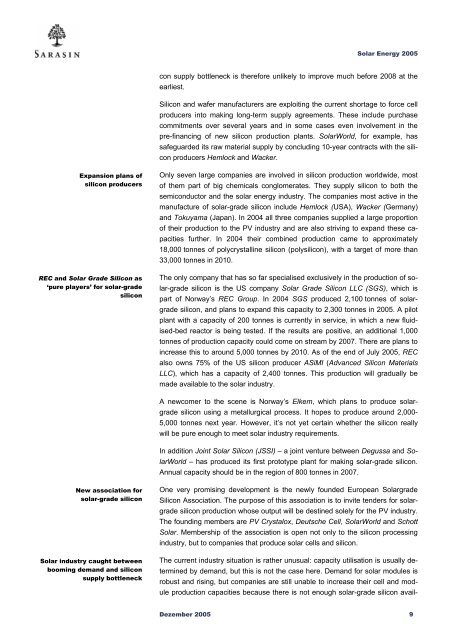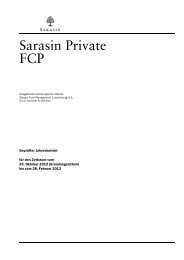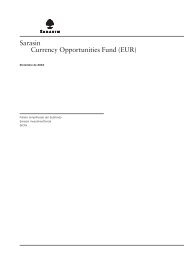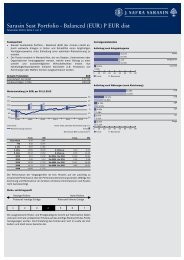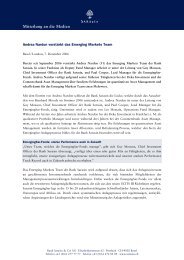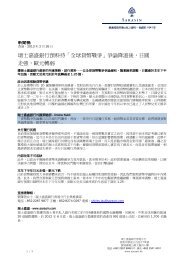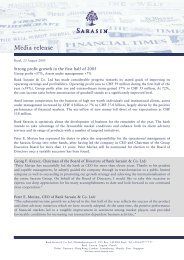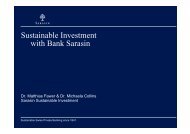Sustainability Report - Bank Sarasin-Alpen
Sustainability Report - Bank Sarasin-Alpen
Sustainability Report - Bank Sarasin-Alpen
Create successful ePaper yourself
Turn your PDF publications into a flip-book with our unique Google optimized e-Paper software.
Solar Energy 2005<br />
con supply bottleneck is therefore unlikely to improve much before 2008 at the<br />
earliest.<br />
Silicon and wafer manufacturers are exploiting the current shortage to force cell<br />
producers into making long-term supply agreements. These include purchase<br />
commitments over several years and in some cases even involvement in the<br />
pre-financing of new silicon production plants. SolarWorld, for example, has<br />
safeguarded its raw material supply by concluding 10-year contracts with the silicon<br />
producers Hemlock and Wacker.<br />
Expansion plans of<br />
silicon producers<br />
REC and Solar Grade Silicon as<br />
‘pure players’ for solar-grade<br />
silicon<br />
Only seven large companies are involved in silicon production worldwide, most<br />
of them part of big chemicals conglomerates. They supply silicon to both the<br />
semiconductor and the solar energy industry. The companies most active in the<br />
manufacture of solar-grade silicon include Hemlock (USA), Wacker (Germany)<br />
and Tokuyama (Japan). In 2004 all three companies supplied a large proportion<br />
of their production to the PV industry and are also striving to expand these capacities<br />
further. In 2004 their combined production came to approximately<br />
18,000 tonnes of polycrystalline silicon (polysilicon), with a target of more than<br />
33,000 tonnes in 2010.<br />
The only company that has so far specialised exclusively in the production of solar-grade<br />
silicon is the US company Solar Grade Silicon LLC (SGS), which is<br />
part of Norway’s REC Group. In 2004 SGS produced 2,100 tonnes of solargrade<br />
silicon, and plans to expand this capacity to 2,300 tonnes in 2005. A pilot<br />
plant with a capacity of 200 tonnes is currently in service, in which a new fluidised-bed<br />
reactor is being tested. If the results are positive, an additional 1,000<br />
tonnes of production capacity could come on stream by 2007. There are plans to<br />
increase this to around 5,000 tonnes by 2010. As of the end of July 2005, REC<br />
also owns 75% of the US silicon producer ASiMI (Advanced Silicon Materials<br />
LLC), which has a capacity of 2,400 tonnes. This production will gradually be<br />
made available to the solar industry.<br />
A newcomer to the scene is Norway’s Elkem, which plans to produce solargrade<br />
silicon using a metallurgical process. It hopes to produce around 2,000-<br />
5,000 tonnes next year. However, it’s not yet certain whether the silicon really<br />
will be pure enough to meet solar industry requirements.<br />
In addition Joint Solar Silicon (JSSI) – a joint venture between Degussa and SolarWorld<br />
– has produced its first prototype plant for making solar-grade silicon.<br />
Annual capacity should be in the region of 800 tonnes in 2007.<br />
New association for<br />
solar-grade silicon<br />
Solar industry caught between<br />
booming demand and silicon<br />
supply bottleneck<br />
One very promising development is the newly founded European Solargrade<br />
Silicon Association. The purpose of this association is to invite tenders for solargrade<br />
silicon production whose output will be destined solely for the PV industry.<br />
The founding members are PV Crystalox, Deutsche Cell, SolarWorld and Schott<br />
Solar. Membership of the association is open not only to the silicon processing<br />
industry, but to companies that produce solar cells and silicon.<br />
The current industry situation is rather unusual: capacity utilisation is usually determined<br />
by demand, but this is not the case here. Demand for solar modules is<br />
robust and rising, but companies are still unable to increase their cell and module<br />
production capacities because there is not enough solar-grade silicon avail-<br />
Dezember 2005 9


